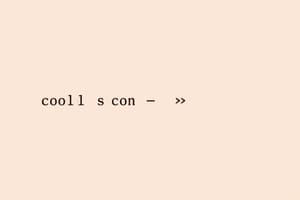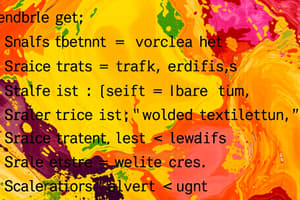Podcast
Questions and Answers
Consider a scenario where you're implementing a custom sequence type in Swift that should seamlessly integrate with for-in loops. To ensure correct iteration behavior, what specific protocol requirements, beyond the basic Sequence protocol conformance, must be meticulously addressed to guarantee deterministic and predictable iteration, especially concerning memory management and handling of potential side effects during iteration?
Consider a scenario where you're implementing a custom sequence type in Swift that should seamlessly integrate with for-in loops. To ensure correct iteration behavior, what specific protocol requirements, beyond the basic Sequence protocol conformance, must be meticulously addressed to guarantee deterministic and predictable iteration, especially concerning memory management and handling of potential side effects during iteration?
- Adopting the `Collection` protocol and providing a custom `Index` type along with implementations for `startIndex`, `endIndex`, and subscript access, ensuring that the index type conforms to `Comparable` and offers stable ordering even under concurrent access scenarios.
- Implementing a custom `IteratorProtocol` with value-typed semantics to avoid shared mutable state and guarantee independent iterator instances, coupled with explicit index boundary checks within the iterator's `next()` method to prevent out-of-bounds access. (correct)
- Employing a combination of lazy evaluation and copy-on-write semantics within the custom sequence and iterator implementations to minimize unnecessary object duplication and defer computation until absolutely needed, combined with careful synchronization mechanisms to handle potential race conditions.
- Leveraging Swift's `UnsafeBufferPointer` for direct memory manipulation during iteration, enhancing performance while meticulously managing memory allocation and deallocation to prevent memory leaks or corruption, especially when dealing with large datasets or external resources.
In Swift, a defer statement guarantees the execution of its enclosed code block regardless of how control is transferred out of the current scope—whether through normal completion, an exception, or an early exit via return, break, or throw—provided that the defer statement itself is reached during execution.
In Swift, a defer statement guarantees the execution of its enclosed code block regardless of how control is transferred out of the current scope—whether through normal completion, an exception, or an early exit via return, break, or throw—provided that the defer statement itself is reached during execution.
True (A)
Elaborate on the nuanced differences between using continue and break statements within nested loop structures in Swift, specifically focusing on how each statement affects the execution flow of both the inner and outer loops, and under what circumstances one might strategically choose one over the other to achieve specific control flow objectives.
Elaborate on the nuanced differences between using continue and break statements within nested loop structures in Swift, specifically focusing on how each statement affects the execution flow of both the inner and outer loops, and under what circumstances one might strategically choose one over the other to achieve specific control flow objectives.
continue skips the remaining code in the current iteration of the innermost loop and proceeds to the next iteration. break terminates the entire innermost loop and transfers control to the next statement after the loop. continue is used to skip specific cases within a loop, while break is used to exit the loop prematurely.
In a switch statement in Swift, the where clause provides a mechanism for adding ______ conditions to a case, enabling more refined pattern matching based on the values bound to temporary constants or variables.
In a switch statement in Swift, the where clause provides a mechanism for adding ______ conditions to a case, enabling more refined pattern matching based on the values bound to temporary constants or variables.
Match each control flow statement in Swift with its primary purpose or use case:
Match each control flow statement in Swift with its primary purpose or use case:
When using a for-in loop to iterate over a dictionary in Swift, what crucial consideration must be taken into account regarding the order of key-value pairs, and how might one ensure consistent iteration order when such consistency is paramount for algorithm correctness or data processing integrity?
When using a for-in loop to iterate over a dictionary in Swift, what crucial consideration must be taken into account regarding the order of key-value pairs, and how might one ensure consistent iteration order when such consistency is paramount for algorithm correctness or data processing integrity?
In Swift, the underscore character (_) can be used as a wildcard pattern within a switch case to match any value, but it is strictly prohibited from being used as a variable name within a for-in loop to explicitly discard the loop variable's value, as this would lead to a compile-time error due to ambiguity in the Swift grammar.
In Swift, the underscore character (_) can be used as a wildcard pattern within a switch case to match any value, but it is strictly prohibited from being used as a variable name within a for-in loop to explicitly discard the loop variable's value, as this would lead to a compile-time error due to ambiguity in the Swift grammar.
Describe a scenario where using a half-open range operator (..<) in a for-in loop would be more appropriate than using a closed range operator (...), and explain the underlying reasoning behind this choice, considering potential off-by-one errors and boundary conditions.
Describe a scenario where using a half-open range operator (..<) in a for-in loop would be more appropriate than using a closed range operator (...), and explain the underlying reasoning behind this choice, considering potential off-by-one errors and boundary conditions.
When employing Swift's switch statement with value binding and a where clause, the scope of the bound constants or variables is strictly limited to the ______ in which they are defined, preventing unintended access or modification from outside that specific case.
When employing Swift's switch statement with value binding and a where clause, the scope of the bound constants or variables is strictly limited to the ______ in which they are defined, preventing unintended access or modification from outside that specific case.
Match each Swift control flow concept with its most accurate description or characteristic:
Match each Swift control flow concept with its most accurate description or characteristic:
In the context of Swift's switch statement, what are the key distinctions between using pattern matching with value binding and employing a where clause, and under what specific circumstances would one approach be more advantageous than the other in terms of code clarity, performance, and expressiveness?
In the context of Swift's switch statement, what are the key distinctions between using pattern matching with value binding and employing a where clause, and under what specific circumstances would one approach be more advantageous than the other in terms of code clarity, performance, and expressiveness?
Swift’s switch statement necessitates that all possible values of the subject being switched upon are handled exhaustively by the cases provided, unless the subject is an enum with a default case or a closed set of known values, in which case the compiler will generate an error if any potential case is not explicitly addressed.
Swift’s switch statement necessitates that all possible values of the subject being switched upon are handled exhaustively by the cases provided, unless the subject is an enum with a default case or a closed set of known values, in which case the compiler will generate an error if any potential case is not explicitly addressed.
Consider a scenario where you need to iterate over a large dataset stored in a custom data structure, but you only require a subset of the data based on a complex filtering criterion. Describe how you would leverage Swift's for-in loop in conjunction with lazy evaluation and custom iterators to efficiently process only the necessary elements, minimizing memory usage and maximizing performance.
Consider a scenario where you need to iterate over a large dataset stored in a custom data structure, but you only require a subset of the data based on a complex filtering criterion. Describe how you would leverage Swift's for-in loop in conjunction with lazy evaluation and custom iterators to efficiently process only the necessary elements, minimizing memory usage and maximizing performance.
Within the context of Swift's guard statement, failing to include a control transfer statement (such as return, throw, break, or continue) within the else clause will result in a ______ error, as the compiler enforces the requirement that the else clause must unconditionally exit the current scope.
Within the context of Swift's guard statement, failing to include a control transfer statement (such as return, throw, break, or continue) within the else clause will result in a ______ error, as the compiler enforces the requirement that the else clause must unconditionally exit the current scope.
Match each scenario with the most appropriate Swift control flow statement or technique to address it:
Match each scenario with the most appropriate Swift control flow statement or technique to address it:
When working with nested for-in loops in Swift, what are the potential implications of using the continue statement within the inner loop, particularly concerning its impact on the execution of the outer loop and the overall algorithmic complexity of the code?
When working with nested for-in loops in Swift, what are the potential implications of using the continue statement within the inner loop, particularly concerning its impact on the execution of the outer loop and the overall algorithmic complexity of the code?
Swift's switch statement, unlike its counterparts in some other languages (e.g., C++), inherently prevents 'fallthrough' behavior between cases; thus, the break statement is entirely optional and serves no functional purpose within a switch block in Swift.
Swift's switch statement, unlike its counterparts in some other languages (e.g., C++), inherently prevents 'fallthrough' behavior between cases; thus, the break statement is entirely optional and serves no functional purpose within a switch block in Swift.
Explain how one might employ a combination of Swift's defer statements and custom error handling mechanisms (e.g., throwing functions and do-catch blocks) to guarantee the consistent release of resources (such as file handles or network connections) in the face of both synchronous and asynchronous operations that may potentially throw errors.
Explain how one might employ a combination of Swift's defer statements and custom error handling mechanisms (e.g., throwing functions and do-catch blocks) to guarantee the consistent release of resources (such as file handles or network connections) in the face of both synchronous and asynchronous operations that may potentially throw errors.
When using the for-in loop to iterate through a sequence, if the number of iterations needs to be programmatically altered mid-loop based on complex conditions, it is generally advisable to refactor the logic to use a ______ loop instead, providing more granular control over the iteration process.
When using the for-in loop to iterate through a sequence, if the number of iterations needs to be programmatically altered mid-loop based on complex conditions, it is generally advisable to refactor the logic to use a ______ loop instead, providing more granular control over the iteration process.
Relate each of the following Swift control flow elements with its primary function when dealing with asynchronous code execution:
Relate each of the following Swift control flow elements with its primary function when dealing with asynchronous code execution:
Flashcards
Control Flow Statements
Control Flow Statements
Statements that control the order in which code is executed, including loops and conditional statements.
While Loop
While Loop
A loop that executes a block of code repeatedly as long as a condition is true.
If, Guard, and Switch Statements
If, Guard, and Switch Statements
Statements that execute different code blocks based on whether a condition is true or false.
Break Statement
Break Statement
A statement that terminates a loop's execution.
Signup and view all the flashcards
Continue Statement
Continue Statement
A statement that skips the rest of the current iteration of a loop and moves to the next iteration.
Signup and view all the flashcards
For-In Loop
For-In Loop
A loop that iterates over a sequence of items, such as arrays, ranges, or strings.
Signup and view all the flashcards
Defer Statement
Defer Statement
A statement that executes code when the current scope is exited, regardless of how it is exited.
Signup and view all the flashcards
For-In Loop Purpose
For-In Loop Purpose
Iterates over a sequence (array, range, string) to perform an action on each item.
Signup and view all the flashcards
Dictionary Iteration
Dictionary Iteration
Keys are decomposed into a constant called animalName, and the dictionary’s values are decomposed into a constant called legCount.
Closed Range
Closed Range
A range that includes both its starting and ending values.
Signup and view all the flashcards
Ignoring Loop Values
Ignoring Loop Values
Using _ in a for-in loop
Signup and view all the flashcardsStudy Notes
- Swift has a variety of control flow statements, including loops and conditional execution.
- Control flow statements like
breakandcontinuecan transfer execution to different points in the code. - The
for-inloop iterates over arrays, dictionaries, ranges, strings, and other sequences. - The
deferstatement executes code when exiting the current scope. - Swift's
switchstatement is more powerful than in C-like languages; it can match patterns like intervals, tuples, and specific type casts. switchcase values can be bound to temporary constants or variables and can use awhereclause for complex matching conditions.
For-In Loops
for-inloops are used to iterate over sequences like arrays, number ranges, or characters in strings.- The example shows how to use a
for-inloop to iterate over the items in an array
Example Array
let names = ["Anna", "Alex", "Brian", "Jack"]
for name in names {
print("Hello, \(name)!")
}
// Hello, Anna!
// Hello, Alex!
// Hello, Brian!
// Hello, Jack!
- Dictionaries can be iterated over to access key-value pairs as
(key, value)tuples. - The tuple's members can be decomposed into named constants within the loop's body.
- In this example, animal names are assigned to animalName, and leg counts are assigned to legCount
Example Dictionary
let numberOfLegs = ["spider": 8, "ant": 6, "cat": 4]
for (animalName, legCount) in numberOfLegs {
print("\(animalName)s have \(legCount) legs")
}
// cats have 4 legs
// ants have 6 legs
// spiders have 8 legs
- Dictionaries are inherently unordered, so iteration order isn't guaranteed to match insertion order.
- The example prints the first few entries in a five-times table.
Numeric Ranges
for index in 1...5 {
print("\(index) times 5 is \(index * 5)")
}
// 1 times 5 is 5
// 2 times 5 is 10
// 3 times 5 is 15
// 4 times 5 is 20
// 5 times 5 is 25
- Iteration occurs over a range of numbers, from 1 to 5 inclusive, using the closed range operator (
...). - The value of index is automatically set at the start of each loop iteration.
indexdoesn't need to be declared before use, as it's implicitly declared in the loop declaration.- You can ignore sequence values by using an underscore (
_) in place of a variable name.
Example Power Calculation
let base = 3
let power = 10
var answer = 1
for _ in 1...power {
answer *= base
}
print("\(base) to the power of \(power) is \(answer)")
// Prints "3 to the power of 10 is 59049"
- This simplifies the code and prevents access to unnecessary values during each iteration.
- The example calculates 3 to the power of 10, where the counter values are unnecessary.
Studying That Suits You
Use AI to generate personalized quizzes and flashcards to suit your learning preferences.




